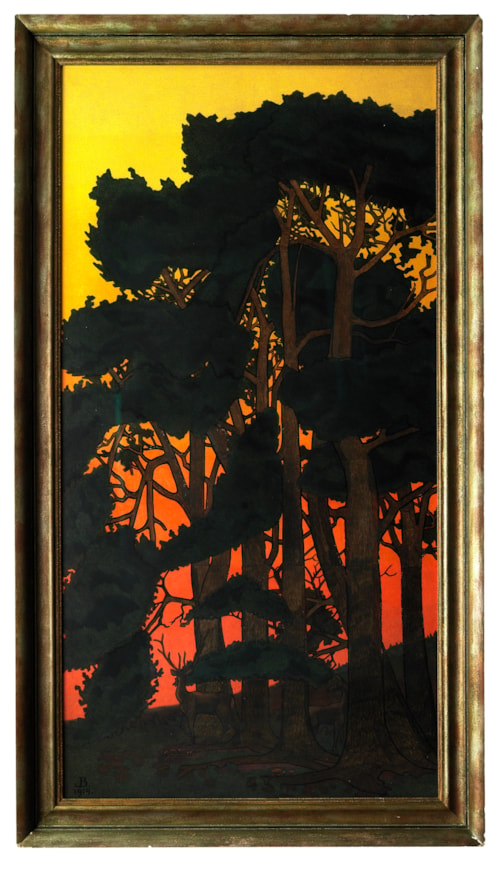
Johan BRIEDÉ
Rotterdam 1885 - Amsterdam 1980
Biography
Johan (Johannus) Briedé was a painter, draughtsman, graphic designer, lithographer, illustrator and typographer. He was a student of the painter Willem Adriaan van Konijnenburg, the artist and designer Chris Lebeau and the graphic designers and bookbinders Geraldo Abraham Brender à Brandis and Ludwig Willem Reymert Wenckebach. From 1910 onwards Briedé established a career as a freelance artist for various magazine and book publishers, as well for as the architect H. P. Berlage. As a young artist he worked throughout the Netherlands; in Amsterdam, Haarlem, The Hague, Leiden, Rijswijk, Rotterdam and Scheveningen. He lectured at the School of Visual Arts in Roermond between 1912 and 1913, and later taught at the Academy of Fine Arts in Rotterdam, the Royal Academy in The Hague and the Institute of Applied Art in Amsterdam. In 1915 Briedé provided 130 elaborate pen drawings of buildings to illustrate the book Oude Huizen van Rotterdam (Old Houses of Rotterdam); a valuable record of the city before much of it was destroyed during the Second World War. The following year he settled in Laren, where he worked for over forty years.
Between 1910 and 1928, Briedé kept a notebook in which he listed a complete and detailed record of his output, whether in the form of paintings, drawings or watercolours, as well as drawn designs for bookplates (for which he became especially known), bookbindings, advertising images, calendars, posters and so forth. (During this eighteen-year period, according to these records, Briedé produced around three thousand drawings and a hundred paintings.) Throughout the 1920s he designed, illustrated and wrote articles for Ons Eigen Tijdschrift (Our Own Magazine), a periodical published by the Van Houten chocolate factory in Weesp, for whom he also created some chocolate boxes. Among the many books illustrated by Briéde were H. G. Wells’s The War of the Worlds, The Invisible Man and The Food of the Gods. Wells and Briedé became friends, with the author praising Briedé as ‘A brilliant young artist from Holland’, and noting of his illustrations for The War of the Worlds: ‘Now comes Mr. Briedé...to probe the Martian mystery, ‘The War of the Worlds’. His Martians are much more vegetable than those of any previous reconstructor, and his Martian machines like living things.’
In the 1910s and early 1920s, Briedé painted landscapes in a pointillist style, but by the 1930s and 1940s he was working in a more conventional Post-Impressionist manner. He travelled to Germany, Spain and Sweden, where he painted a number of beach and coastal scenes. By 1959 Briedé had settled in Amsterdam, where he continued to work until his death at the age of ninety-five. Works by the artist are today in the Stedelijk Museum and the Rijksprentenkabinet in Amsterdam, as well as in collections of museums in Assen, The Hague, Hilversum, Laren, Leiden, Rotterdam and Weesp.
Briedé was apparently quite shy and somewhat averse to publicity, and perhaps as a result only a few exhibitions of his work were mounted in his lifetime; notably in Laren in 1932 and in Amsterdam in 1974, as well as a posthumous exhibition of his flower and nature studies at the Gemeentemuseum in Weesp in 1992. There were also relatively few critical or scholarly studies of his work during his long career. In one of the very few contemporary accounts of the artist’s work in English, published in The Studio in 1923, it was noted that ‘Johan Briedé is the art director of an iron foundry, the designer of many posters and advertisements and an illustrator of tales of imagination, those of Edgar Allan Poe having a special fascination for him. A lover of great towns and of quiet nature, familiar with the practical side of life, he is yet ever and anon fleeing from it in his dreams and queer fancies. His talent has a sharpness and a coolness which makes one think of steel pens and microscopes; his imagination seems to move with the preciseness of clockwork and the glitter of subtle machinery; and yet it makes one dream, it breathes the poetry of unreal and wonderful worlds and always shows in some way or other a love of nature.’


